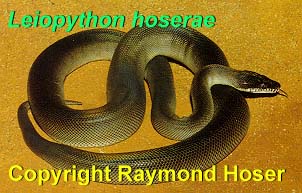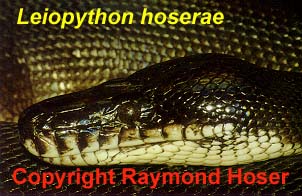LEIOPYTHON HOSERAE SP. NOV.
|
Scroll down the page to view photos of this snake or to download either as (less than) 1 MB high resolution images: |
HOLOTYPE: A large male specimen in the American Museum of Natural History from Wipim (=Wipam), Western District, PNG, Lat: 8° 40' Long: 142° 55', specimen number 107150. The snake has a body length of 6ft 10.5 inches and a total length of 7ft 11 inches.
DIAGNOSIS: This is the species formerly known as the black race of the White-lipped Python. L. hoserae is separated from L. albertisi by the fact that its dorsal body colour is usually a greyish metallic black in adults as opposed to a golden brown colour. L. hoserae also attains a larger size, with this author having sighted and photographed a specimen at Melbourne Zoo of about 2.5 metres, (also refer to the type specimen above). L. albertisi rarely if ever attains this size. Live L. hoserae are shown in Hoser (1989), O'Shea (1996) and Ross and Marzec (1990).
The specimens depicted in Hoser (1989) are derived from the Port Moresby area (Chris Banks, Melbourne Zoo, pers. comm). There are numerous other characteristics that separate the two species of Leiopython, including DNA properties. L. hoserae cannot be confused with any other New Guinea snake. L. hoserae occurs in the southern areas of PNG, south of the main central range, including the area around Port Moresby, and adjacent parts of Irian Jaya around Merauke where it is understood to be relatively uncommon and/or rarely collected there.
It is uncertain as to how far west the distribution of this species extends. Nor is it certain if this distribution is continuous or disjunct. However notwithstanding the previous statement about the species around Merauke, this species is like L. albertisi in that it is usually common where it occurs. L. hoserae is not as common in captivity as L. albertisi. The species is understood to also occur on Islands just south of New Guinea in the Torres Strait area, that fall within Australian territory (refer to Cogger 1996) and other sources. The species also occurs in the Aru Islands to the south, where it is understood to be reasonably common.
ETYMOLOGY: Named after the author's wife, Shireen Hoser.
The above was from the paper - A revision of the Australiasian Pythons.
(Originally published in Ophidia Review 1(1) in "Autumn" 2000 - (Publication date: October 2000), pp. 7-27).
For the text of the full paper ![]()
 Download the full paper as an MS Word document (better for printing)
Download the full paper as an MS Word document (better for printing)![]()


 To download the original of this paper - with
photos exactly as it appeared in the journal Ophidia Review - as an Adobe Acrobat pdf file
To download the original of this paper - with
photos exactly as it appeared in the journal Ophidia Review - as an Adobe Acrobat pdf file